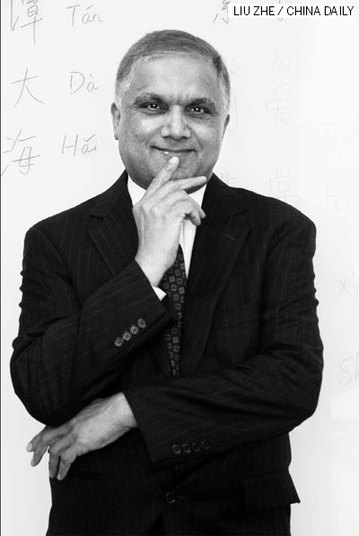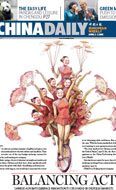People
The allure of coal, culture
Updated: 2011-03-27 07:56
By Lin Jing (China Daily)

There is a big white writing board in Tayeb Tahir's office, about 1 meter tall and 50 cm wide, hanging right beside his bookshelf. On the board are several Chinese characters with the Chinese pinyin and intonation, including Tan Dahai, his Chinese name.
 |
"My Chinese colleague gave me that name. It means the big ocean," he said, stretching his arms and smiling. And he likes it very much, he said.
Tahir is president of Peabody China, a branch of the NYSE-listed Peabody Energy, the world's largest private-sector coal company that operates in 23 countries.
A native of Pakistan, Tahir went to the United States in 1979 to study gas technology and coal conversion technology and got his master's degree. Then he worked at the Illinois Institute of Technology in Chicago, where many new technologies were being developed.
"That was a time when there was an energy and oil crisis, and there was not enough oil for cars. So the US government was investing a lot in clean coal solutions," he said.
After gaining extensive engineering and management experience in the energy industry in the US, he joined Peabody Energy in 2006.
In 2005, the company began its business development in China. Tahir was named president of Peabody China in late 2007 and moved to Beijing shortly thereafter.
As the world's second largest economy behind the US, "China would obviously require more energy", said Tahir. "The fundamental need in China is to have easy and cheap access to energy, to improve people's lives."
Peabody recently signed two deals with Chinese companies to develop coal mines and coal-powered electric plants. The first was with the China Huaneng Group to develop a clean coal electricity generation project with carbon capture in the Inner Mongolia autonomous region.
The project will include a large surface coal mine and technology to convert carbon dioxide into cement-like building materials,
"As more power is needed, increasingly more carbon dioxide will be produced," he said. "On the other hand, building materials also have the greatest demand. So this is a win-win situation to generate more power and convert that to more building materials."
The second Memorandum of Understanding was signed with a subsidiary of Shandong-based Yankuang Group Co Ltd, to jointly develop a clean energy center in the Xinjiang Uygur autonomous region.
The center will include construction of a coal electricity generation plant and coal-to-natural gas conversion facility fueled by a new open-cut coal mine.
"China is becoming a leader in coal conversion technology," he said.
"My own view is that China has invested a lot in clean energy technology in the last few years and continues to spend more on research and development institutes that provide cutting edge research."
He said that in the future, China might export some technologies to other countries.
Tahir traces his earliest awareness of China to his childhood, in Pakistan.
He said at that time people wore badgesbearing ChairmanMao Zedong's portrait and China would sometimes send acrobatic troupes to put on shows in his hometown. Though the shows were quite simple, people loved them.
After moving to the US, he got to know China from his school friends and neighbors in New Jersey. "But even so, when I first came to Beijing, it was a lot more modern than my imagination," he said.
"The country is developing at an astonishing speed. Some buildings seem to pop up overnight."
He now lives in Beijing with his wife and two children. His son goes to high school in an international school in Beijing and his daughter has been studying Chinese full time at Tsinghua University for one year before she heads back to the US to study law.
"I keep telling her that she would probably benefit more from learning Chinese than three to four years of law school," he said.
At first he planned to stay in China for a year and a half. But after living here for a while, he became increasingly interested in the country.
He likes to travel, and his favorites regions are the Inner Mongolia autonomous region and the XinjiangUygurautonomousregion.
"In Xilin GolLeague and Hohhot, you can see different scenery from mountains to deserts, interesting food and different types of people, languages, singing and dancing," he said.
"People who do not live in China cannot realize the great diversity of this country. So I am fortunate to be able to see that."
Beyond his ambitious business plan, Tahir also has a personal goal: Doing volunteer work. He said he was inspired by a movie he saw many years ago.
Pay It Forward, starring Kevin Spacey, is about an experimental project by a school teacher. A child was told to do something kind for three other children without asking anything for return. The only condition is that these kids would do this to three other people.
Later the project became a national phenomenon, where people felt happy to give away their belongings.
"It is a great movie and also my favorite. To give without expecting anything back is a lot more rewarding than anything else."
E-paper

Green mission
Tony blair believes China will take a leading role to fight climate change and cut emissions.
Stepping on to success
French connection
Generation gaps
Specials

Have you any wool?
The new stars of Chinese animation are edging out old childhood icons like Mickey Mouse and Hello Kitty.

Fill dad's shoes
Daughter and son are beginning to take over the family business of making shoes.

Virtual memorial
High-Tech touches to traditional tombsweeping festival help environment.
